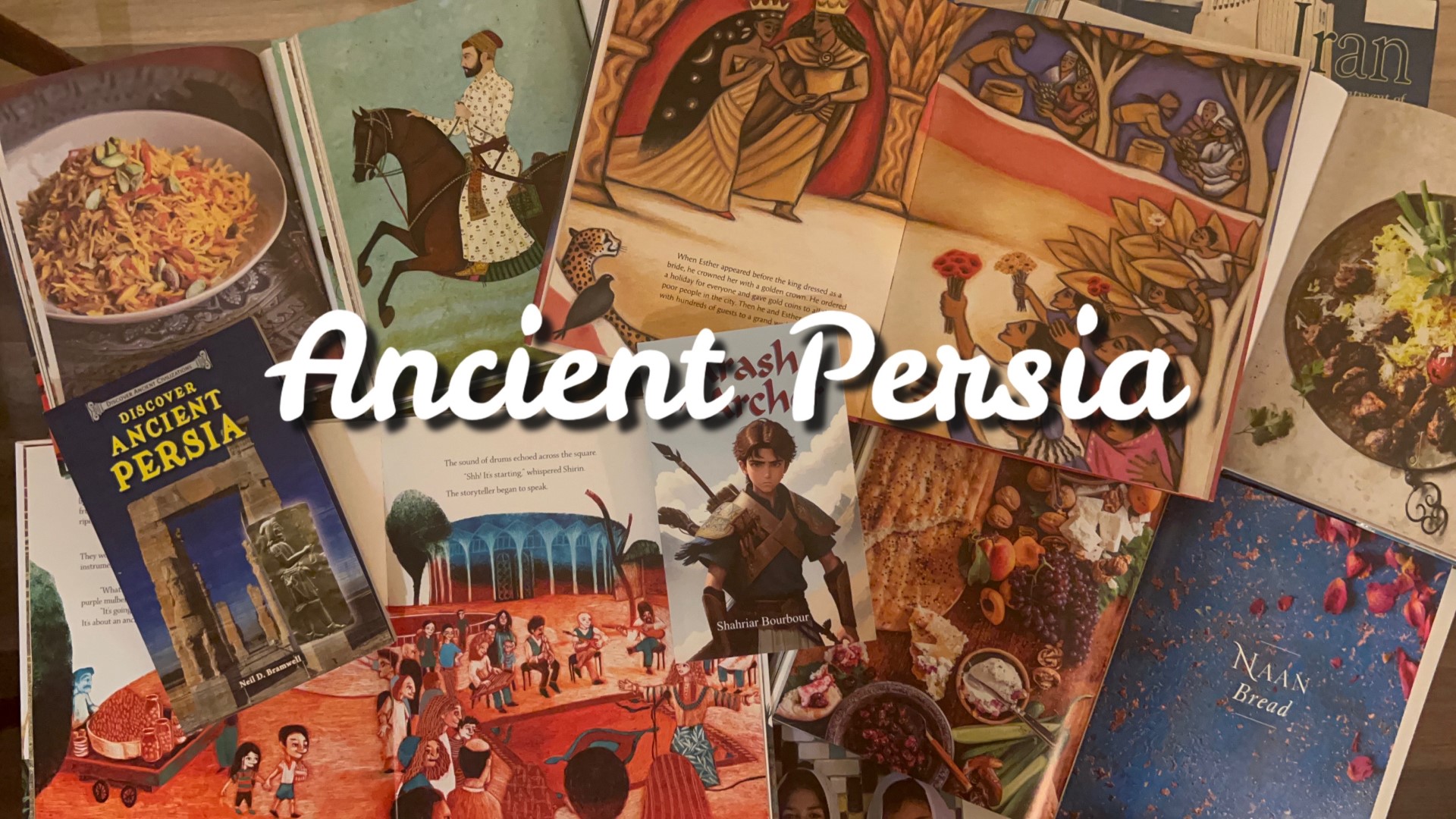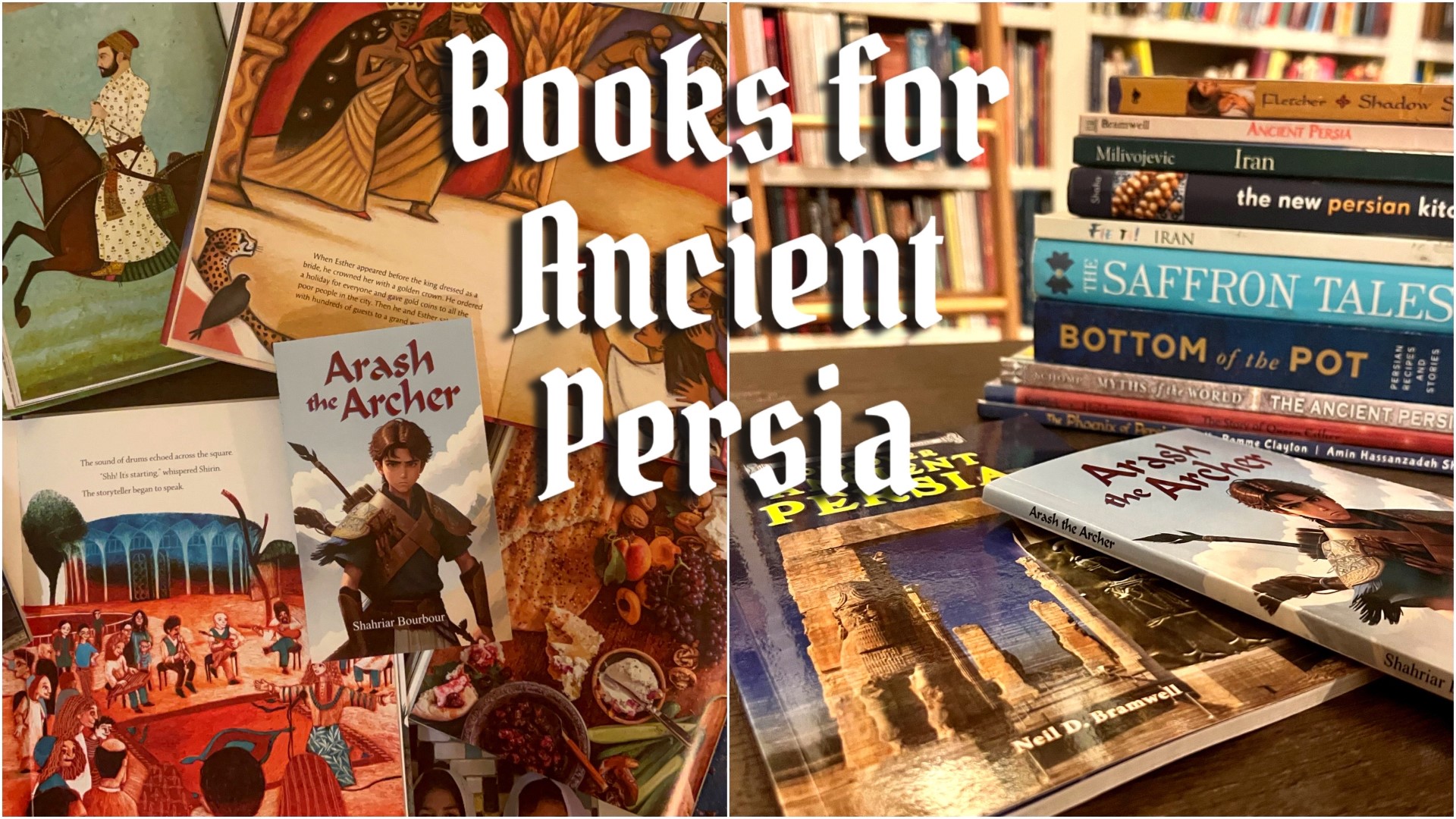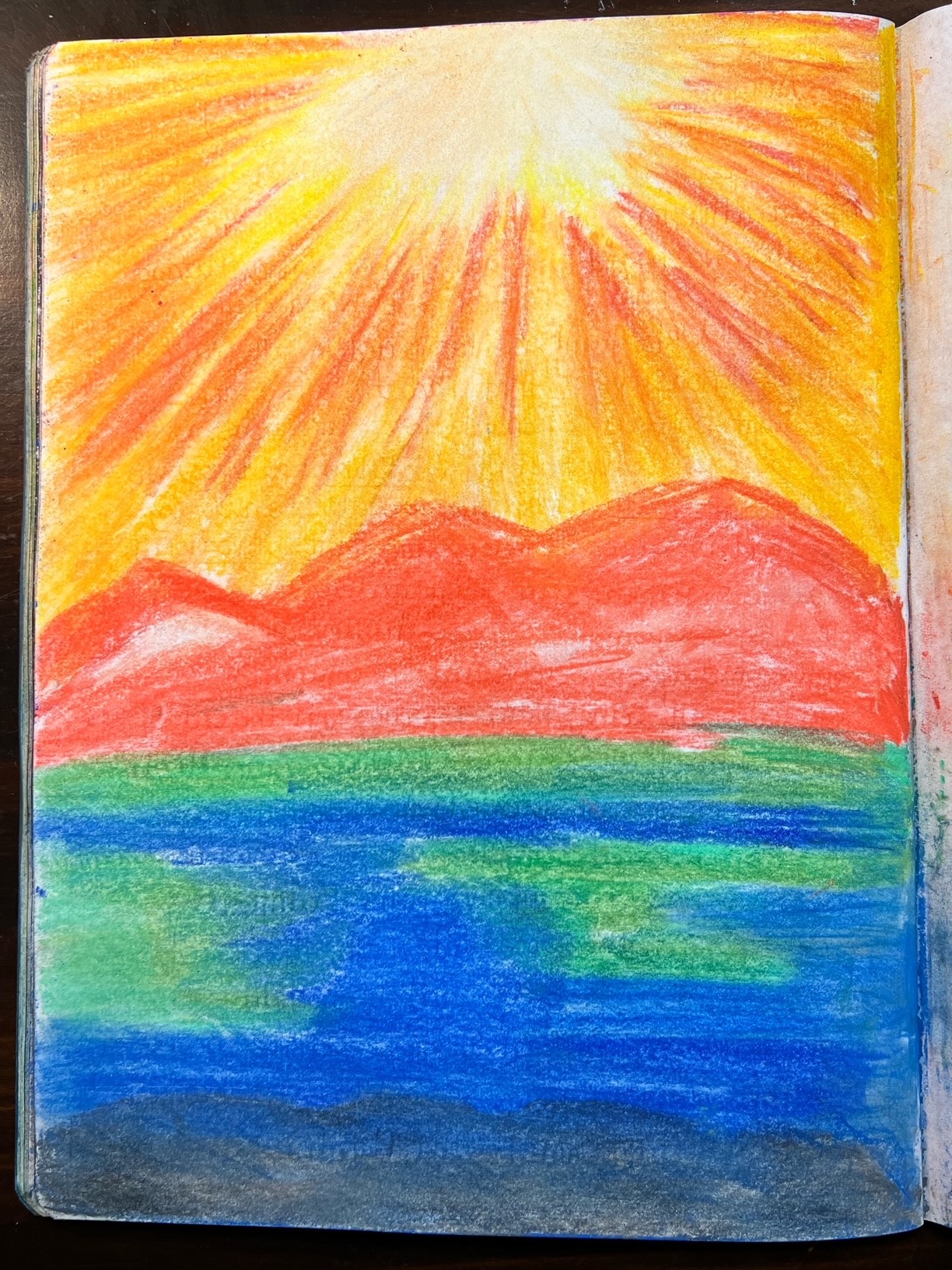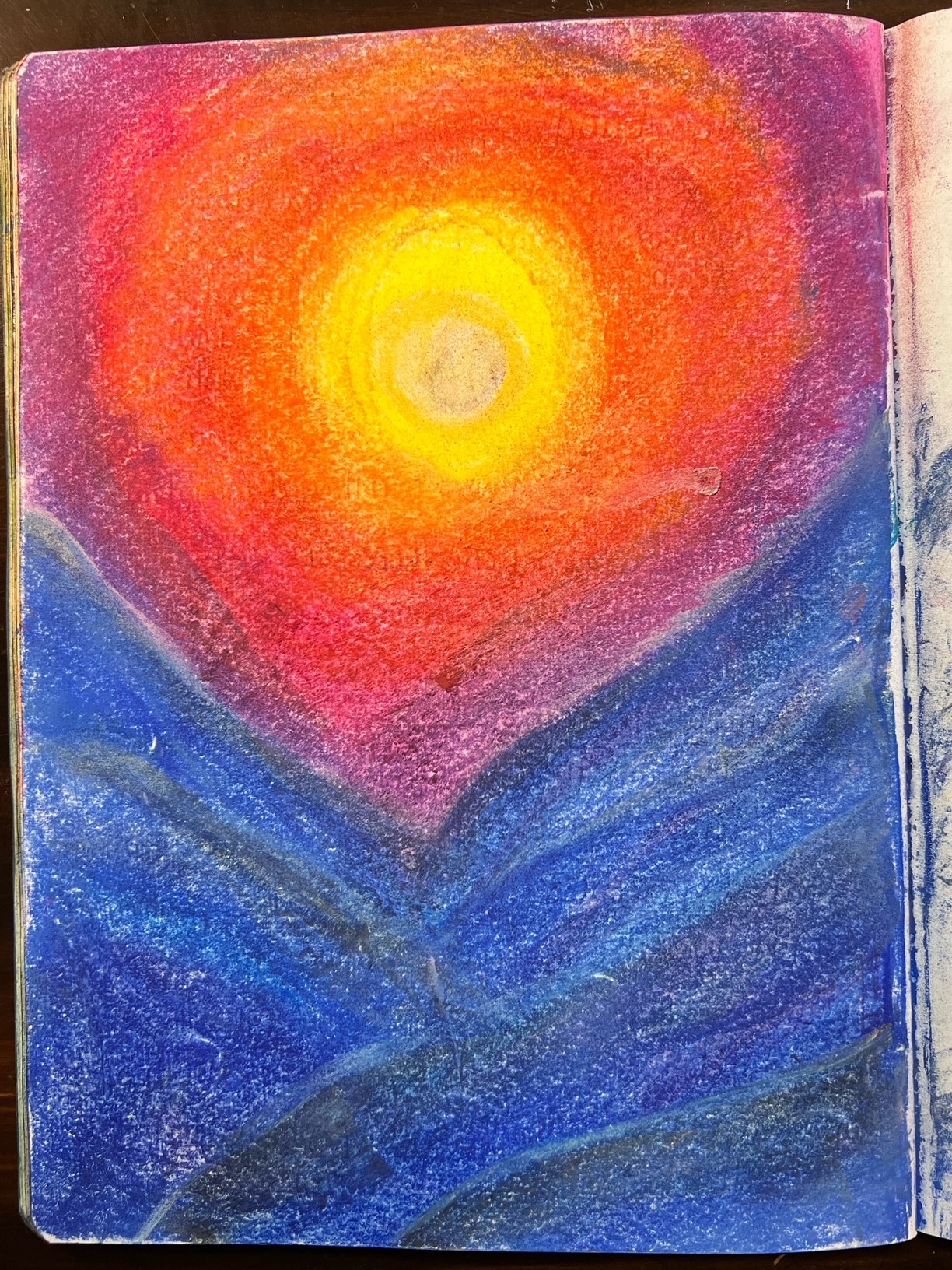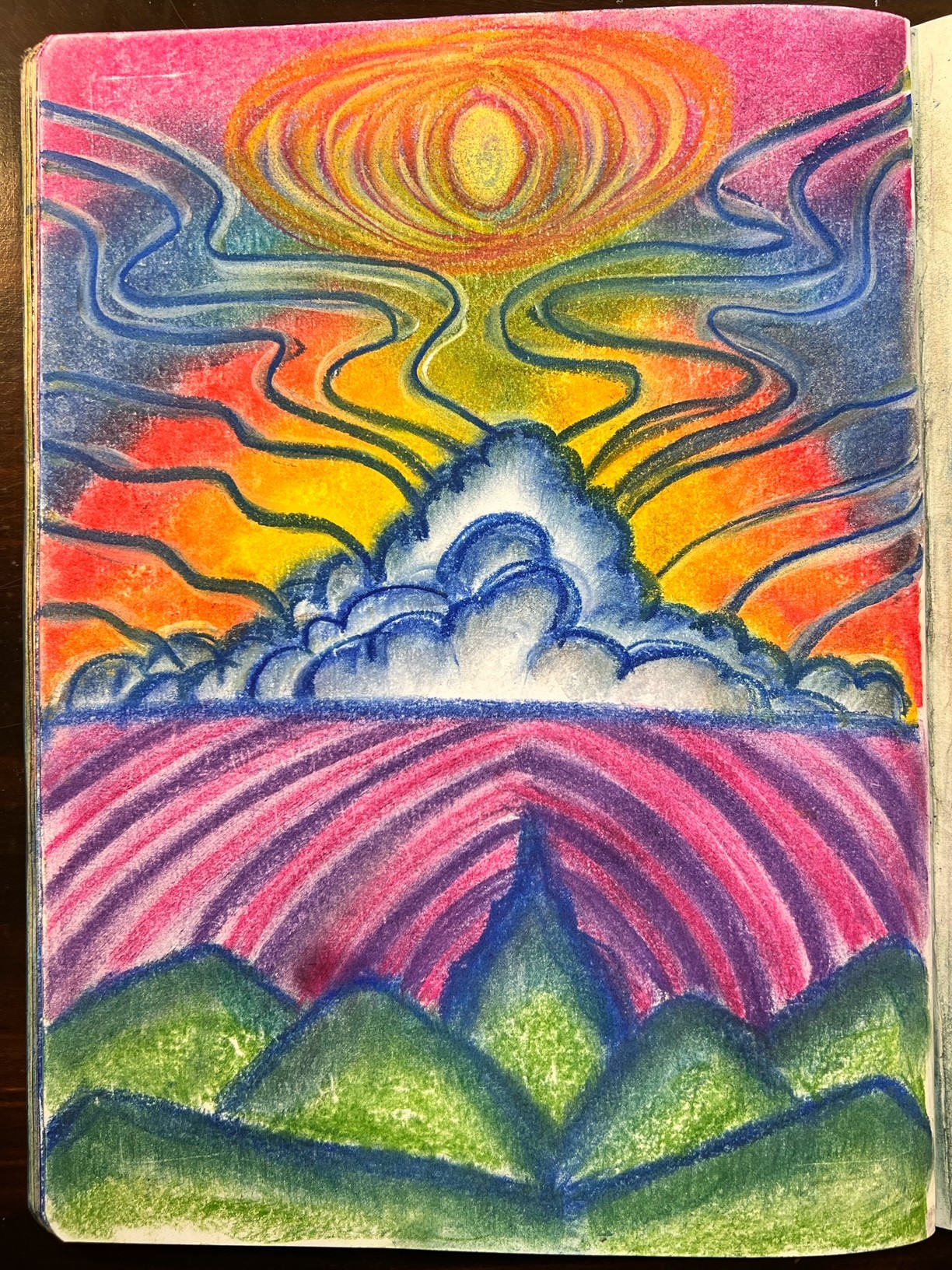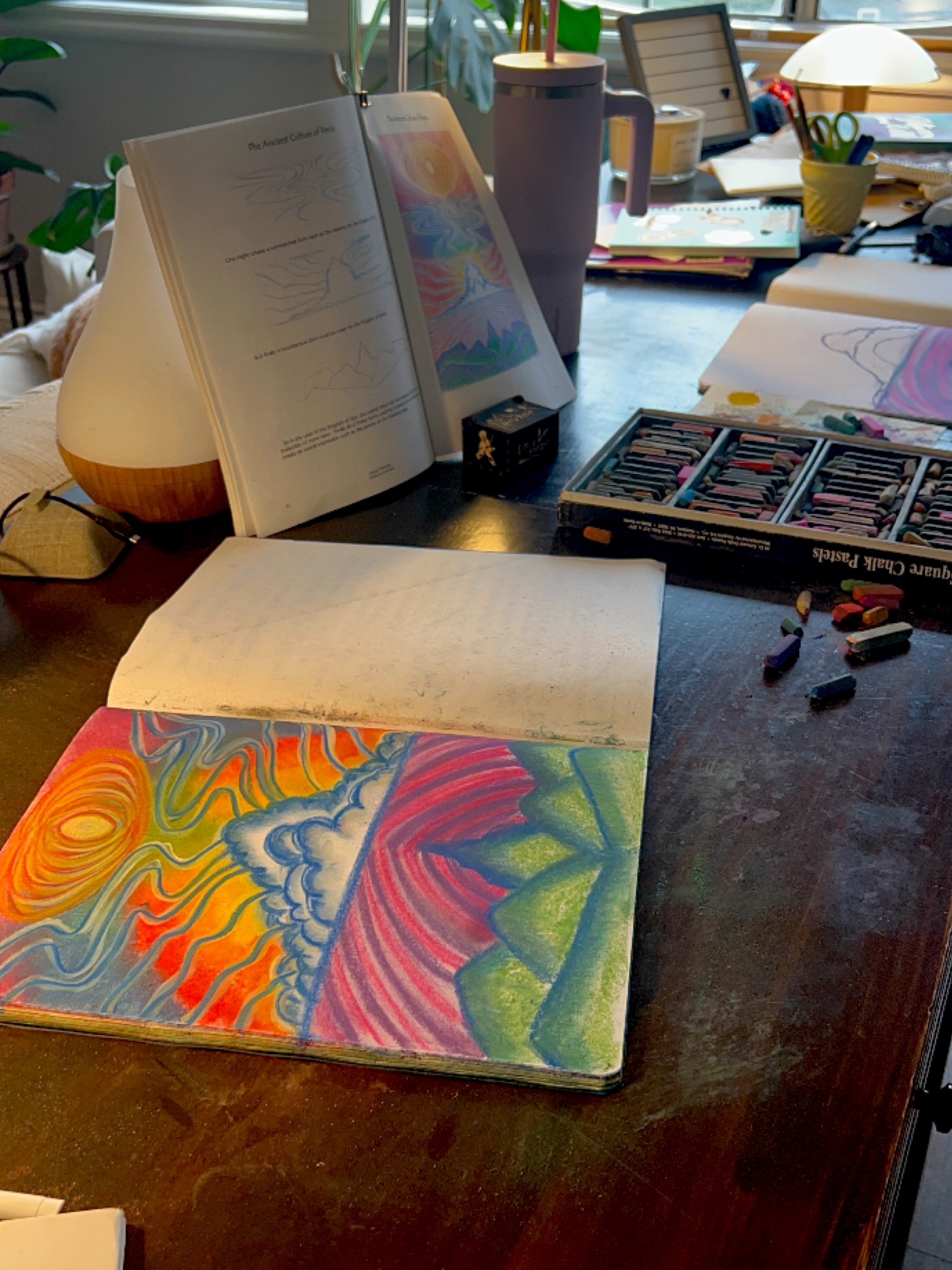I start my lessons on Ancient Persia in the kitchen years before we read a single book. In part because we love Persian (Iranian) food deeply and have learned several recipes from my friend Teyebeh who is a profoundly talented cook. Most of not all of the recipes featured for this unit are recipes I got from my friend. These have been family favorites for years and it has been our delicious introduction to this unit. We are doing the ancient civilizations a year late. The year we should have been doing them, I was grief stricken from the passing of my sister while also preparing for my son to be married while also making plans to renovate our school room. For that year, we resorted to online classes and in person classes to bridge the gap. It meant we put aside most of our Waldorf lessons. So a year later when we should be doing other lessons, we are playing catch-up. What it looks like is an abridged version of our rich units and main lesson blocks filled with books, projects, recipes and main lesson work. This unit (at the moment) doesn’t showcase much more than books and recipes along with our main lesson book work. I wish we had time for more, but we will attempt to move swiftly through the ancients.
Books & Resources
- Live Education Waldorf curriculum the Ancient Culture of Persia year five
- The Ancient Persians, Myths of the World by Virginia Schomp
- Civilizations of the Ancient World Ancient Persia by Neil D Bramwell published 2004
- Discover ancient, civilizations, discover ancient Persia by Neil D. Bramwell, published 2014
- The Shadow Spinner by Susan Fletcher
- Arash, the Archer by Shahriar Bourbour
- Iran, a Portrait of the Country Through its Festivals and Traditions by Grolier Iran, Enchantment of the World, by JoAnn Milivojevic
- The Saffron Tales by Yasmin Khan Bottom of the Pot
- Persian recipes and Stories by Naz Deravian
- The New Persian Kitchen by Louisa Shafia
- The Phoenix of Persia, by Sally Pomme Clayton and Amin Hassanzadeh Sharif
- The Story of Queen Esther written by Jenny Koralek and illustrated by Griselda Holderness
- Main lesson books by A Child’s Dream
- Sergeant Art Square chalk pastels
- Blick Matte fixative
- World Tales for Family Storytelling, volume 3 51 traditional stories for children, aged 8 to 11 years by Chris Smith
- Ancient science, by Jim Wiese
- Companions at the Prophet volume 1 by Abdul Wahid Hamid The story of Salman al-Farsi chapter 20 page 159
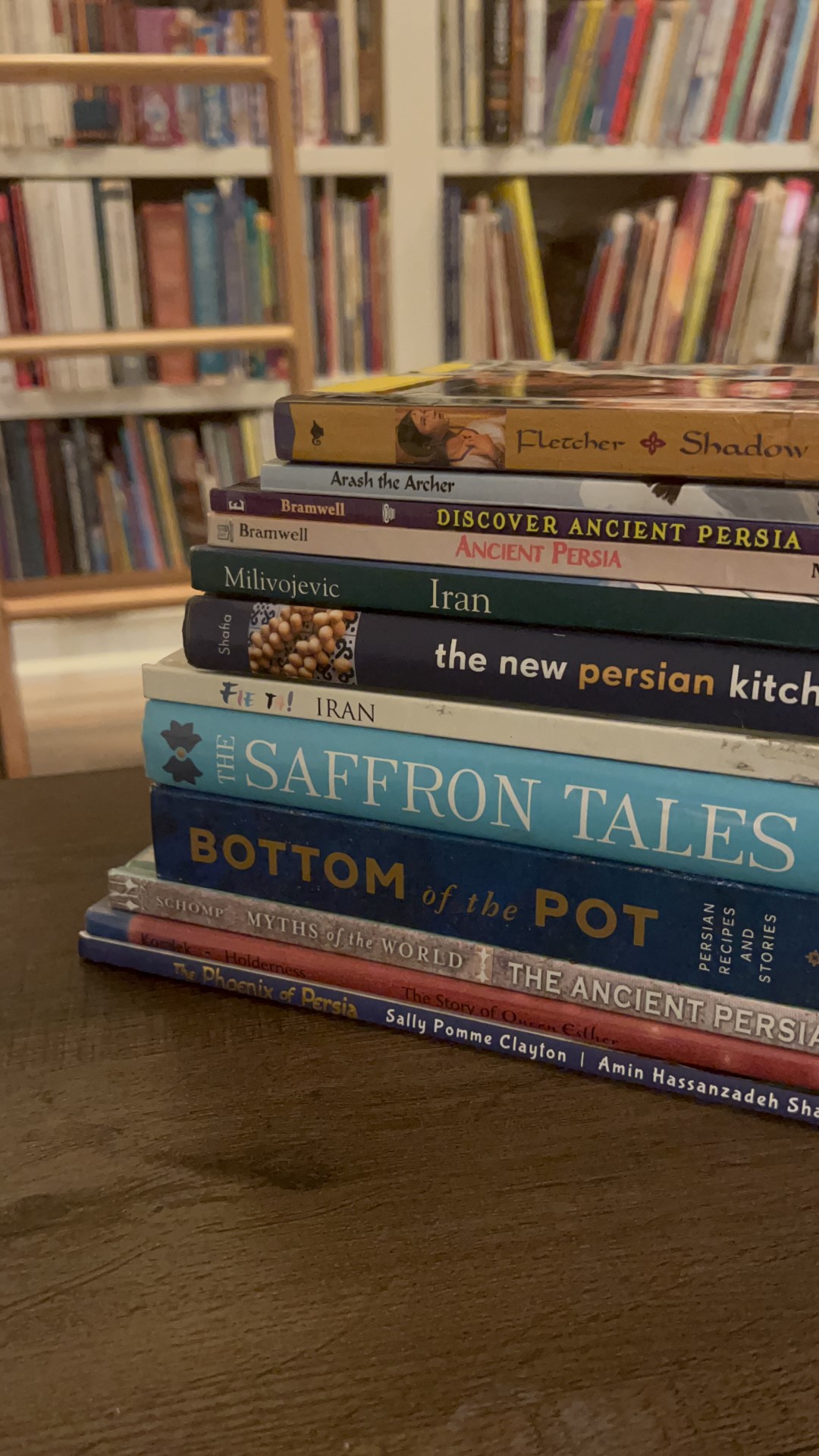
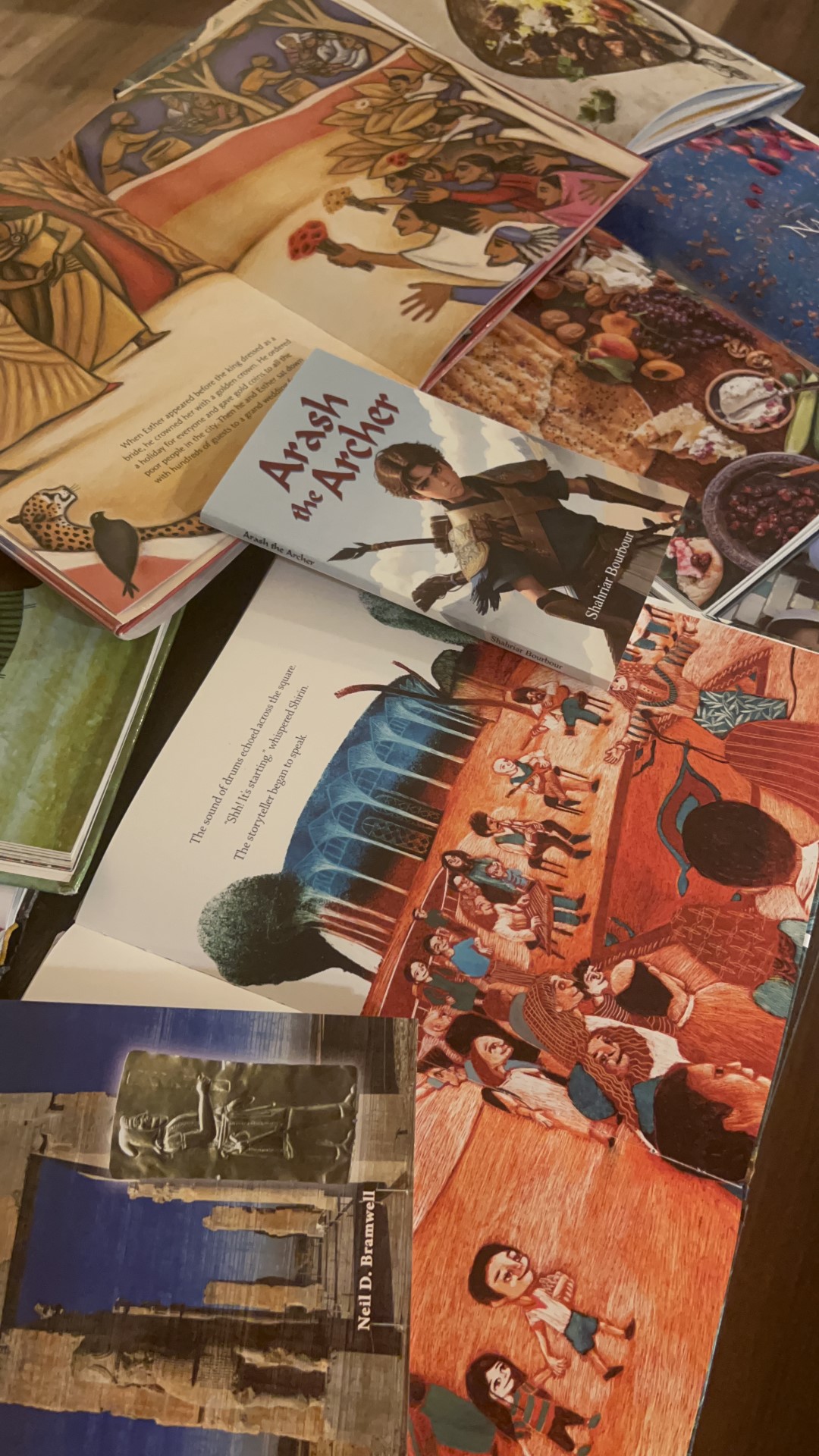
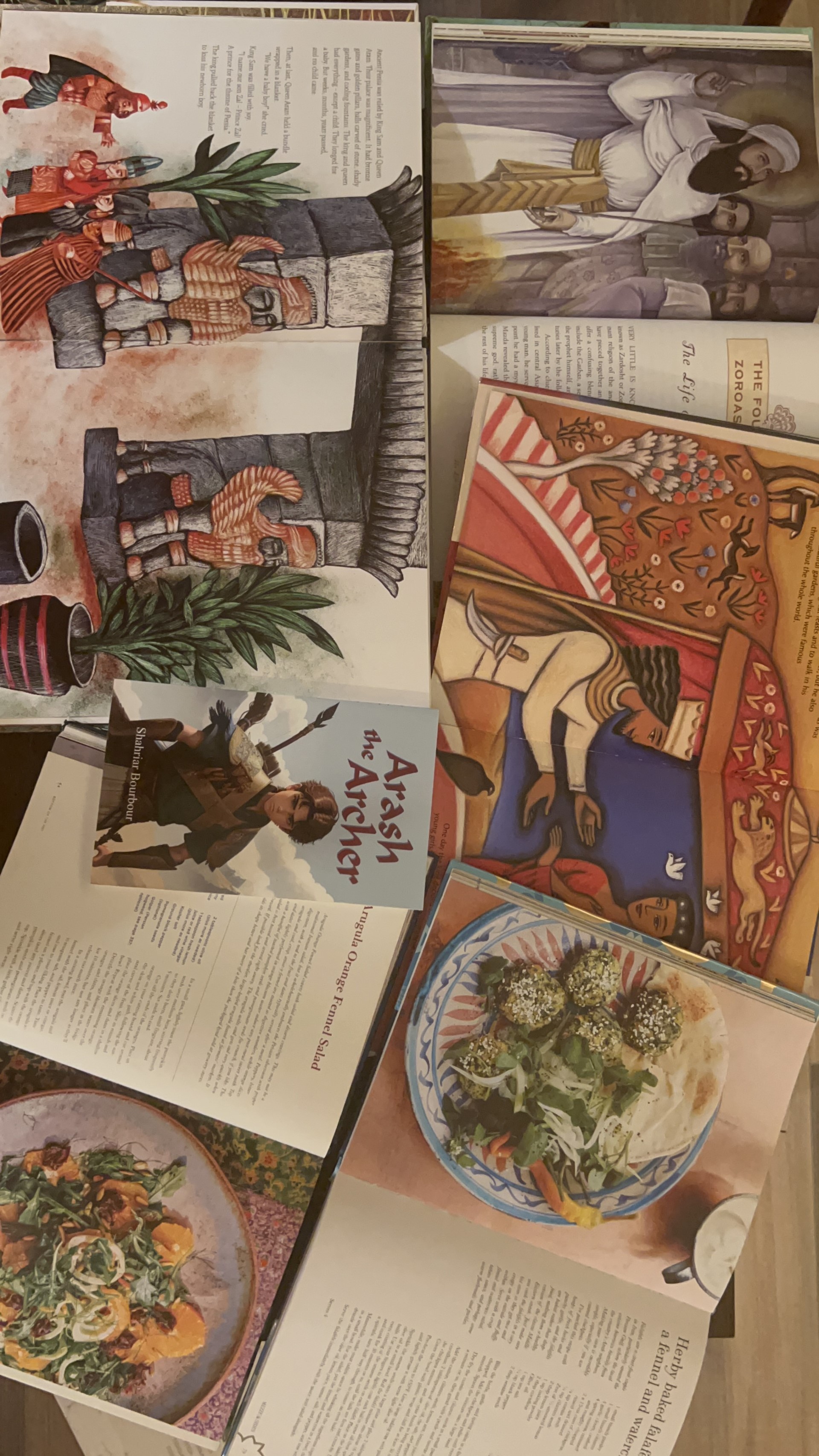
Main Lesson Book
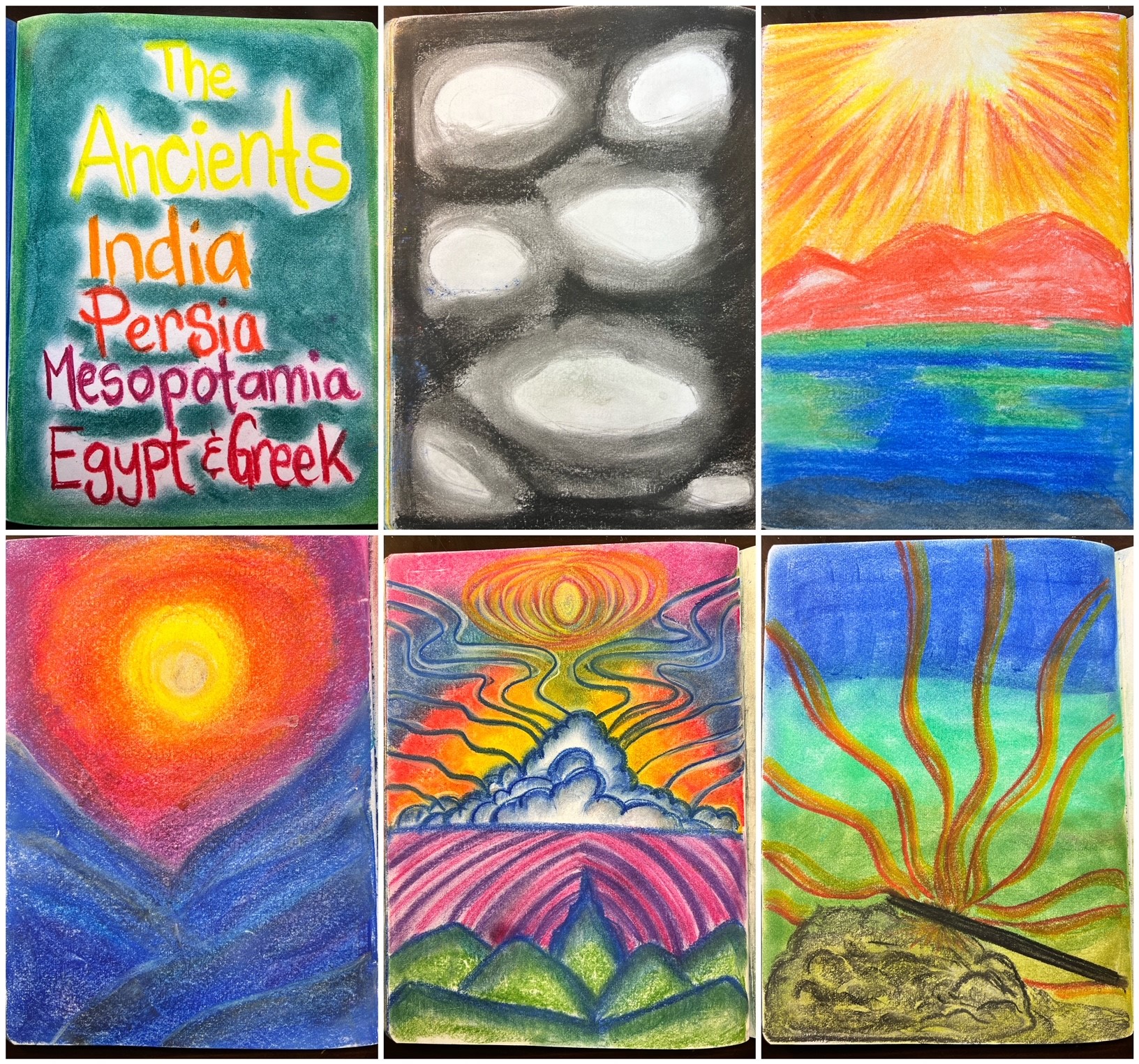
We continue our main lesson book entries using our Sargent Art chalk pastels. We use a matte fixative to seal the chalk and keep it from smearing. These are some of the entries we made for this main lesson block. If you’d like to see the process for Lesson 2: The Creation Story of the Ancient Persian, the coming together of light and dark and the middle world of land and see, click HERE. You may also follow on Instagram and TikTok for a daily look at how we homeschool.
This lesson was on the geography and landscape of ancient Persia. I decided to draw this image from the book which was attached to another lesson. The drawing suggested was of a more realistic mountain range which would have depicted the landscape more accurately. We may revisit that drawing later in the unit, but for now we worked on this rich mountain scape with warm sunset sky. To see the process video for this lesson, click or tap HERE.
I have two videos to share for this lesson which is an artistic representation of the spiritual/religious concept of the Zoroastrians regarding the various kingdoms. We may include form drawing with these lessons like rows of grains, trees etc. but for now you can see the symbolism of the sun and its circular rings. The eight earthly kingdoms are the following: Sun, Water, Air, Earth, Food, Health, Human Being, and Joy. To see the quick video tutorial for the drawing of this lesson, click or tap HERE.
I also recorded a slow process video to share the steps to the drawing for this lesson. I’m instructing my daughter as I draw. We are both copying the image in the main lesson book, but she is also copying me and listening to the instructions. We both love the way this drawing turned out and plan to use these techniques in other drawings. Namely, the technique of creating a background then overlaying drawings that are more defined over the smudged background. We used our matte fixative to seal these drawings and also added a boarder in chalk around our written work. Each lesson takes about 3 days with the reading/oral delivery of the lesson coming first followed by writing and drawing on subsequent days. In this way we are constantly doing review while working through new lessons. To see the slow process video, click or tap HERE.
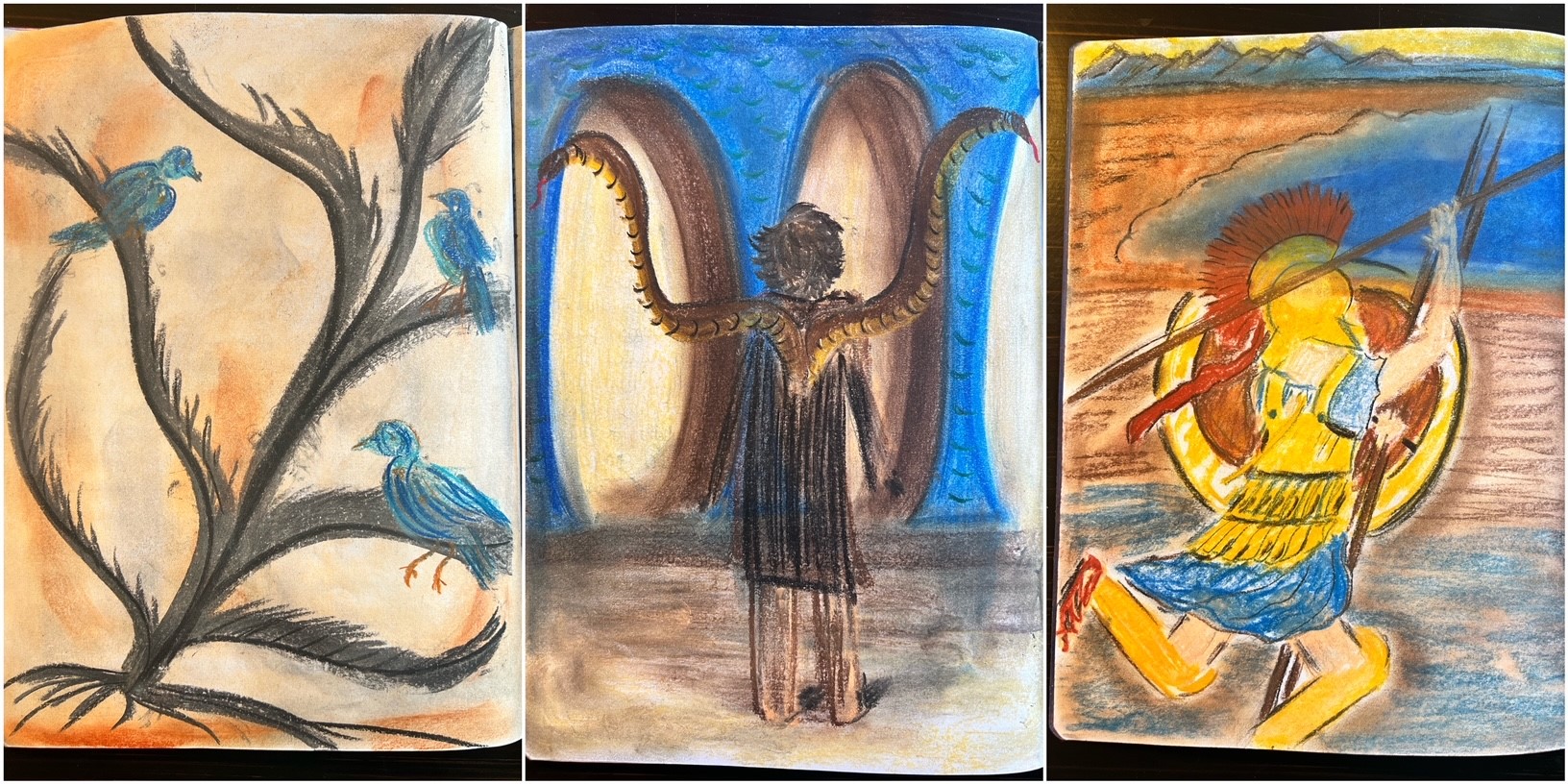
We finished out our main lesson block with a few more lessons from the book The Ancient Persians, Myths of the World by Virginia Schomp. The three images plus the map are inspired by artwork in that book and our written narrations reflect the reading we did from that book.

Recipes
This has got to be the best tastiest rice in the world!! I’m not a fan of rice, but this is one rice dish, I’ll gladly eat. Packed with dates, currants, lentils and fried onions, what’s not to love?! I season mine with olive oil, grapeseed oil, salt and saffron. Occasionally if I make a whole roasted chicken to go along with this rice, I’ll add my secret ingredient: pan drippings! It’s amazing. And if you leave out the pan drippings, this rice dish is VEGAN!! Ingredients: 1 cup brown lentils 3-4 cups basmati rice (you can adjust proportions) 2 cups dates (cut in half or thirds) 2 onions (sliced and fried) 1/2-3/4 cup of currants salt, grapeseed oil, olive oil and saffron Boil lentils for 20-30 minutes until soft and just splitting, but do not overcook. In a separate pot, boil water in excess of rice. We are going to drain the rice, so the rice needs room to move when the water has boiled. If you want to soak your rice, you can soak it and rinse it several times for an hour and up to overnight in the refrigerator. Being that I’m lazy, I usually skip this. Also, I usually don’t wait for my water to boil before putting it in the water, lol, but you can wait until the water is boiling before adding the rice. You can salt the water as well. When the rice is cooked ‘al dente’, where it’s just done, but not too soft, you can drain the rice. This takes about 15 minutes. Be sure to test the rice from 10 minutes on. You do NOT want overcooked rice. In the meantime, fry two onions in oil (I like grapeseed oil). This takes about 15 minutes. You want them very brown, but not burnt. Use extra oil to ensure they won’t burn. At the end of the browning process you can add olive oil to taste. Pit and slice dates. I like to lightly fry the dates and currants in the left over oil from the onions. Be sure to watch them closely as currants will burn fast. Add a bit of ground saffron. Time to assembled the rice: Add a small ‘mountain’ of rice at the bottom or a large pot. Top with dates, currants, onions and lentils. Add layer of rice. Add sprinkling of salt, ground saffron, grapeseed oil and olive oil. Repeat till all ingredients are used up. Let sit for a few minutes so the flavors can mingle and for the saffron to color the rice. Then toss in the pot by flipping the pot towards you. Avoid mixing using a spoon. You do not want to break the rice. If your rice need a little more time to soften, put the lid on and leave it for 10 minutes. Serve with chicken or on it’s own.
Did you know turmeric is so good for you? Aside from being an antioxidant, it’s full of other other benefits for your body and brain. I tend to overdo my turmeric consumption, and this is one chicken recipe that’s full of it! This chicken dish perfectly accompanies Adas Polo, Zeresh Polo and Baghia Polo. Ingredient: Onion (sliced) Chicken (pieces with skin on) salt (to taste) oil (grapeseed oil and olive oil) turmeric (1-2 Tablespoons) optional: saffron (pinch) Directions: Saute 1-2 onions in oil until translucent or even a bit more. Place chicken in the pan with onions, skin side down. Add oil as needed. Season with salt and generous amounts of turmeric. Brown chicken on both sides. Sprinkle with ground saffron. Add about 1/2-1 cup of water after about 5-10 minutes. Transfer browned chicken to baking tray. Be sure to get all the pan drippings onto the chicken. Add 1/2 cup of water for a saucier sauce. Bake uncovered for 30-45 minutes uncovered if skin is on or covered if skin is off. Serve with Adas Polo.
This is one of the most refreshing salads you’ll ever taste! What I love about Persian food is that the ingredients are simple, flavorful and nourishing. Salad Shirzi or Cucumber Salad as I like to call it accompanies many Persian meals. It’s one of two salads you’ll typically find on Persian menus, and this one is so easy to make, you’ll wonder why you don’t have it all the time!! You can make this as big or small as you like it and with whatever ratio you want, but if you want a basic guideline, here it goes: 2 Persian cucumbers 1 medium flavorful tomato 1 lemon salt to taste olive oil optional That’s it!! One thing to note about this salad is that the cucumbers are finely diced. It really does matter how you cut them if you want to be authentic 🙂 The tomatoes are also finely diced, but not as small or they’ll turn to mush. The flavor of the tomatoes matters. Try your best to find ripe, firm and good tasting tomatoes. For this recipe, avoid the cherry tomatoes and grape tomatoes. As tempting as it will be to use them, the sweet tart taste of cherry tomatoes overpowers the other other flavors. Of course, you may do as you wish!! Lemon is really important in this recipe. If your lemons are not juicy, use more. You can’t overdo it on the lemons, so squeeze away! The more the better. And did I mention how good lemons are for you? They are cleansing and detoxifying, so use as many as you can. Persian cucumbers may be a novelty at most grocery stores, so if you can’t get them, English cucumbers are a good alternative. If you must use the standard cucumbers, then I recommend peeling them, but otherwise, for the Persian and English ones, keep the skin on. Add salt to taste, but if you are making this in advance, don’t salt until close to serving time. The salt extracts the liquid from the tomatoes and cucumbers, and you will be left with a bland salad if you salt it too early.
I do love adding sweet to savory and even like orange flavored Chinese chicken, but I didn’t seem to like this dish quite as much. However, my 18-year-old son said it was the best chicken I ever made. So the following day, I made the recipe again and cut down on the orange accents. I left off the orange segments which garnished the dish (and of which I used only 1/6 of what the recipe called for), but still I wasn’t satisfied. I think for my next attempt, I’ll skip the boiled chicken (my alteration of the recipe) and stick to chicken breast as the recipe called for. I didn’t have Persian lime powder, so I used two alternatives together to make up for the loss. Overall this recipe was deeply flavorful and textured and was a needed departure from our typical chicken recipes. This recipe is from The Silk Road Gourmet by Laura Kelley and we have been using this book as inspiration for our Silk Road main lesson block in homeschool. We love adding regional and historical recipes when doing our history units and this book has been a gem. It covers several countries including Azerbaijan, India, Bangladesh and more. We paired our orange chicken koresh (page 130-131) with another Iranian recipe: Chickpea and Dill Rice Pilaf found on page 111 in the book. While both recipes are flavorful, I feel there would be better paired with plain dishes (plain rice with the orange chicken and plain chicken with the chickpea rice), however my children loved the combination and asked for the chicken again the following day and the day after that. The book didn’t pair these recipes together, it was my own thought to do so. Together, the cooking time was nearly 3 hours to make the chicken and rice dish. The second day I made this, the cooking time was just over an hour. If you use canned chickpeas and chicken breast as the recipe calls for rather than boiling a chicken, I think you could get your cooking time down even further.
As a self proclaimed “Not-a-Rice-Fan”, I do make the exception when it comes to Persian rices. They are my favorite and this one did not disappoint. I also don’t care for chickpeas, but when paired with light basmati rice, onions and tomatoes, this rice recipe becomes a meal unto itself. With a slight modification of the recipe, you can make this a vegan or vegetarian recipe easily. As it’s written it calls for chicken broth which infuses the rice with rich flavor that is balanced by the addition of lemon and tomatoes. Onions impart flavor whether they are raw, cooked, sauteed or fried. With a base of tomatoes, onions and garbanzo beans, the rice sits safely on top as the steam cooks the rice to perfection. This recipe was such a hit that my family requested it three days in a row after making it for the first time. We paired it with orange chicken koresh which is a sweet dish which probably would be better balanced with a plain rice dish, but my children loved the combination. Both recipes are from the book The Silk Road Gourmet by Laura Kelley. We are using this book as part of our Silk Road unit study for homeschool and are loving the recipes we are trying out from this book. It contains recipes from several different countries along the ancient Silk Road like Iran, Sri Lanka, Armenia and more.
This is one of our favorite recipes!! I’ve only added fried onions to the recipe as well as a sprinkle of saffron. If you don’t have fresh dill, I’ve swapped it out for dried dill on many occasions. We pair this with a rack of lamb. We got this recipe from the Martha Stewart Living magazine and it’s become on of our favorite recipes ever!!
